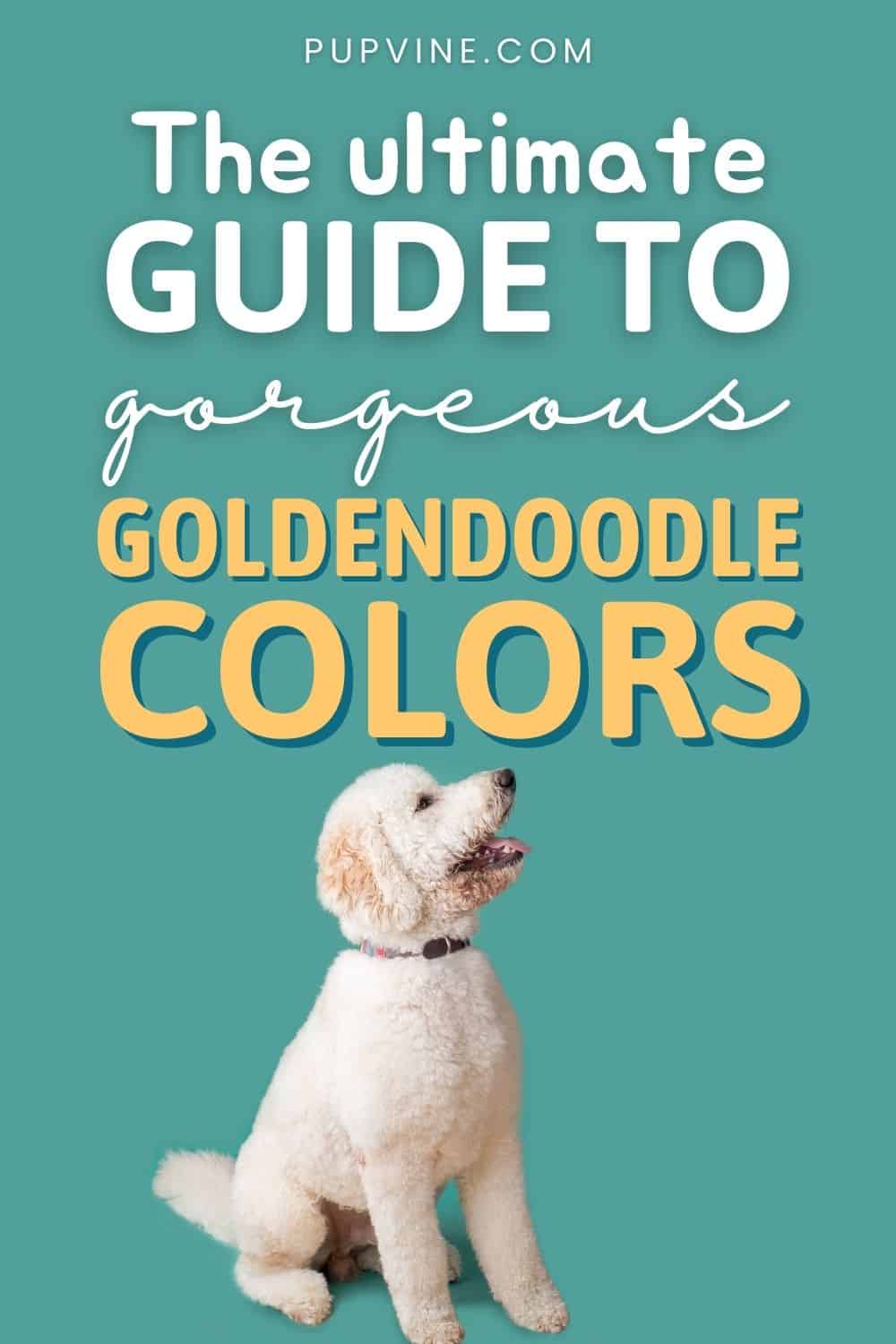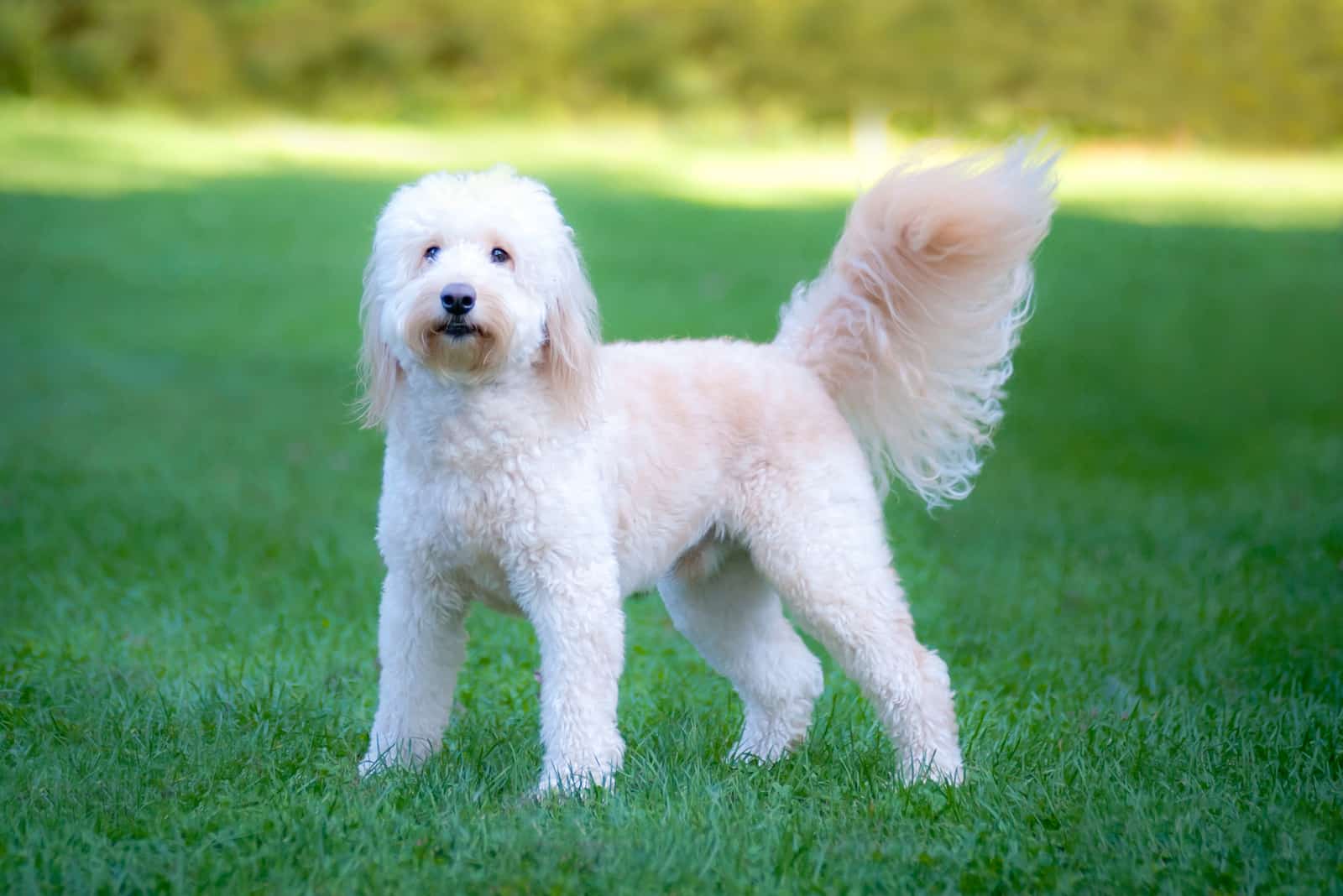Goldendoodles have been very popular lately because of their adorable looks and hypoallergenic traits.
Various Goldendoodle colors have been produced by the crossbreeding of Poodles and Golden Retrievers, including red, black, apricot, and other colors that might be unusual for each of the parent’s breeds but is found acceptable for their hybrids.
Different sizes and shades make these adorable pups even more unique and desirable!
Now you have a chance to learn everything about every type of Goldendoodle coat color and its origin.
Goldendoodle Colors: What Colors Are Acknowledged By Kennel Clubs?
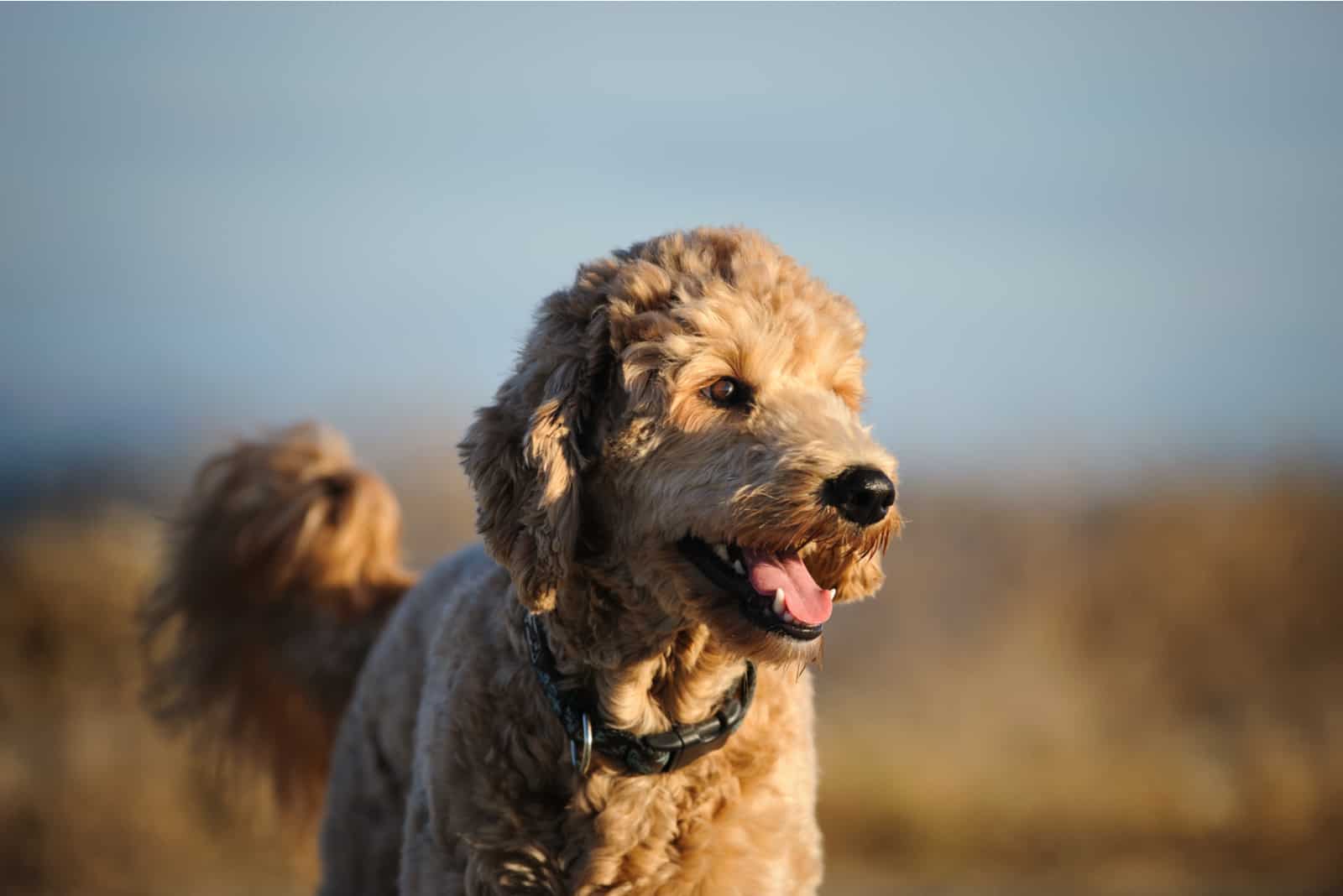
Hybrid canines are generally not accepted as official breeds by the American Kennel Club (AKC). The same goes for Doodles, no matter what color or generation they belong to.
These designer dogs might not be acknowledged by the kennel clubs and other major organizations, but they’re still very popular among people with families and young children.
Although kennel clubs still support purebreds only, there have been some talks lately about the recognition of some crossbred canines.
The reason for this change lies in the fact that many breeders started producing hybrid canines without further examinations on possible diseases and congenital disabilities.
If these breeds are recognized, kennels and dog associations will have the opportunity to control and monitor the production of the mixed breeds.
Now, let’s have a look at the parent colors that are considered standard or non-standard by the AKC and other institutions:
• Golden
• Dark golden
• Light golden
• Black
• White
• Grey
• Silver
• Blue
• Brown
• Red
• Cream
• Apricot
• Silver-beige
Non-standard Poodle colors
• Brown and white
• Black and apricot
• Cream and white
• Black and white
• Gray and white
• White and silver
• Black and gray
• Red and apricot
• Red, black, and silver
• Blue and white
• Silver, black, and tan
• Black and cream
• White and apricot
• Red and white
• Brown and apricot
• Cafe au lait
• Black and brown
Now that you know which colors are approved or not when it comes to Poodles and Retrievers, you realize why there are so many different Goldendoodle colors!
Goldendoodle Colors
From brown Goldendoodles to the one-of-a-kind merle ones, these pups have made our lives sweeter and happier since the day they appeared.
Now is the time to discover everything you didn’t know about these beautiful animals and their coat types!
Apricot Goldendoodle

This canine type is probably the most common Goldie shade. The reason why it’s high in demand is that this doggie resembles an adorable and fluffy teddy bear.
One of the most common misconceptions about this type of Goldie is related to its color. Many people confuse the apricot shade with light brown or mocha.
Although they look almost the same, minor differences in lightness and saturation of the apricot shade differentiate it from the above-mentioned colors.
This shade is the heritage of the Poodle ancestors and is acknowledged by the American Kennel Club (AKC). That’s why this is considered a standard color, although many would say the name of this shade isn’t as frequent among dog breeds.
Interestingly, the apricot Goldie’s coat might become lighter in the older age, which is why many people think that this Goldendoodle carries the Golden Retriever’s color gene.
Red Goldendoodle
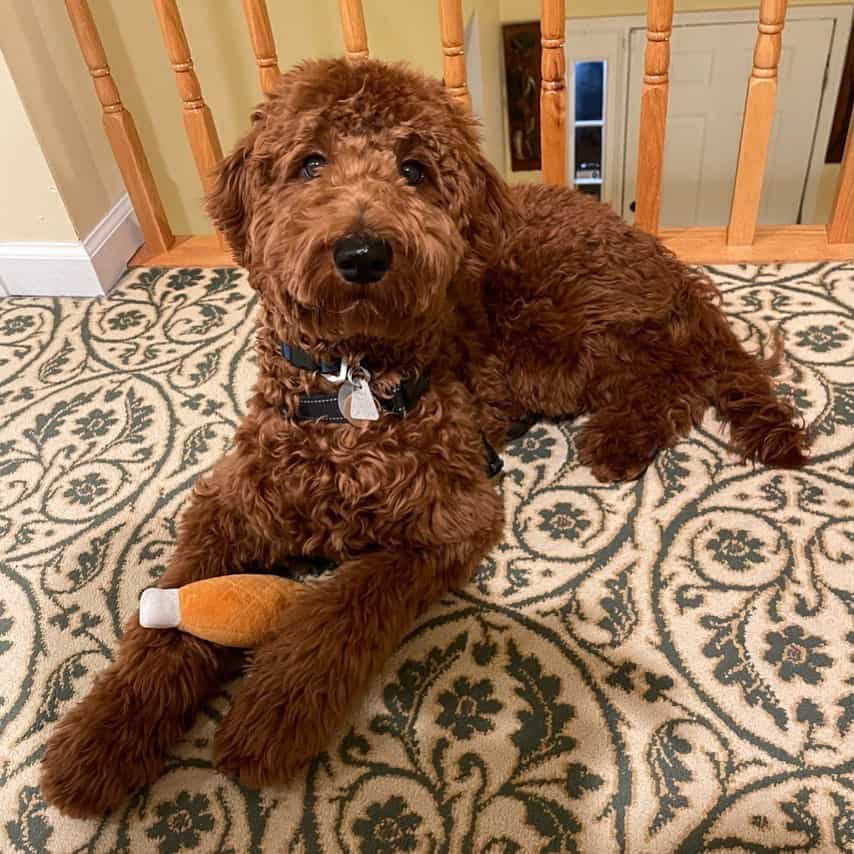
Photo from: @good.dood.teddy
Red Goldendoodles are royals among all shades of this dog breed. These puppies look very classy, but they’re also lovable, which is why these pups are high in demand.
This type of Goldendoodle is colored with a dazzling red shade, making this dog even more adorable. The fluffy fur with a mahogany hue adds to the Goldendoodle’s uniqueness and makes it even more desirable among other dog breeds.
Red Doodles are similar to apricots and chocolates because they also inherit the coat shade from Poodles. Their color changes as they mature, although they don’t become as light as apricots.
The red color isn’t accepted by the AKC as a standard shade of Poodles, although it’s pretty common.
You can get a Red Goldendoodle by crossbreeding a darker Poodle with a standard Golden Retriever!
Cream Goldendoodle
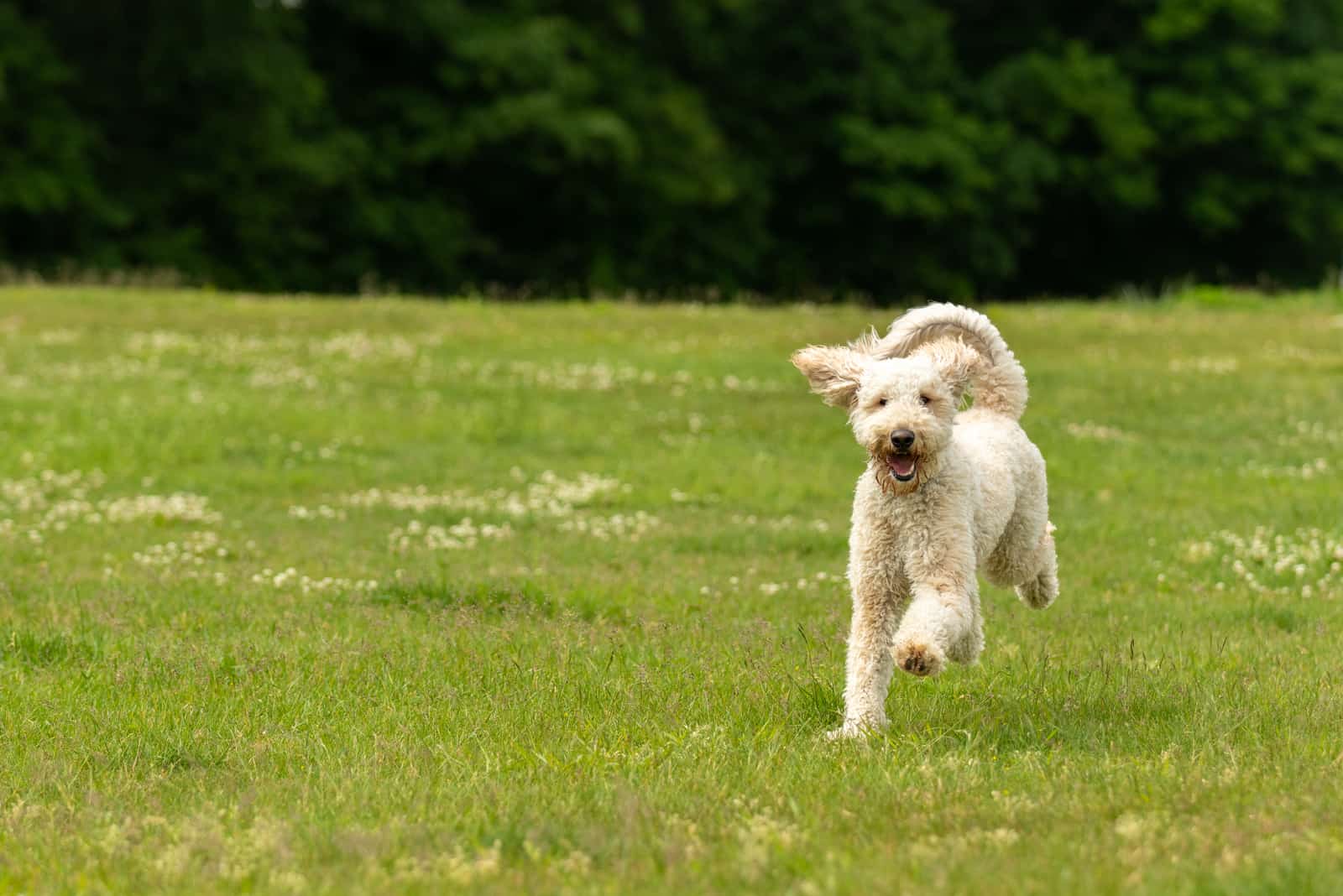
This color is probably one of the most used shades among breeders trying to make colorful coat patterns, such as merle Goldendoodles, phantom Goldendoodles, or a parti Goldendoodle.
The cream color is generally considered typical, although that may not be entirely true.
The cream shade is quite unique because of the variety of colors on the dog’s coat that are different for almost every Goldendoodle puppy.
Some pups might have lighter hues around their eyes, eye rims, toenails, and other parts of the body.
They might also have brown noses, unlike red or chocolate Goldies, who have darker noses.
There’s one thing that might not immediately catch your attention, although it’s characteristic of this coat color. The skin underneath the cream Goldie’s coat hair seems pale pink, which proves how unique each dog shade is.
When it comes to the origin of this color, opinions are somewhat divided. Some people claim cream Goldies got their shade from the Golden Retriever’s side, while others are sure this hue is the heritage of cream Poodles, an official color of this dog breed.
However, it’s believed that the cream color comes from the mixture of red and apricot versions of the Goldendoodle.
Cream Goldies are often confused with white ones or even with Labradoodles, just because they share similar colors. However, if you look closely at all of these coat types, you’ll realize visible differences between them.
Black Goldendoodle
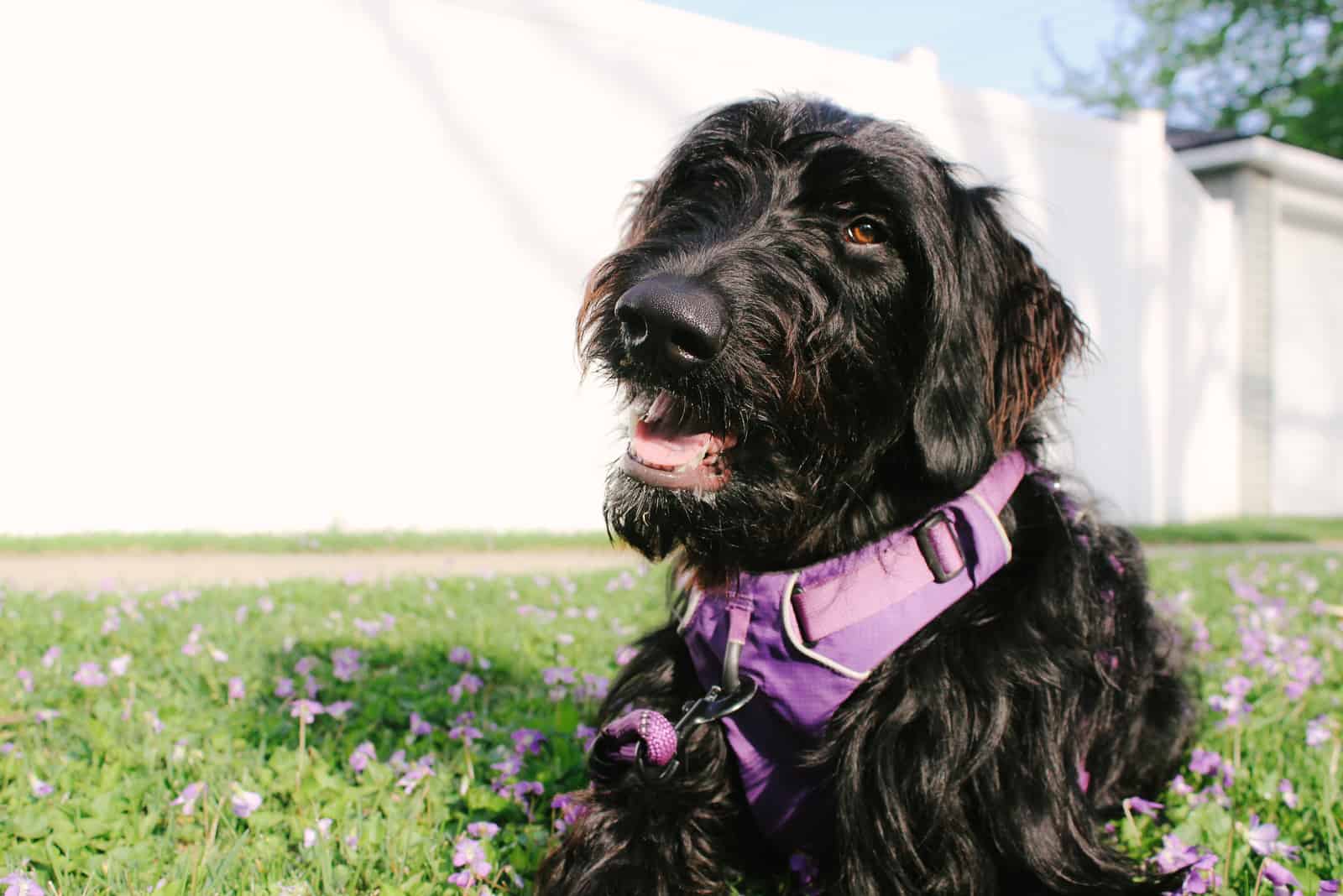
If there can be black Poodles and black Golden Retrievers, why couldn’t there be a black Goldendoodle as well?
Dark Goldies are more unique than any other color of Goldendoodles, which is why they’re prevalent nowadays.
The beauty of the shiny, black-colored curly coat will make you fall in love instantly with this doggie. Those looking for more unique canines are delighted by the good looks of the black Goldie.
This color can be inherited by both parents, but it comes from the recessive gene, meaning that this gene has to be carried by both parents in order to be inherited.
Black Goldendoodles generally don’t have any variations in coat pattern. The coat hair on their paw pads, noses, eye rims are always black.
But, this black dog might become a silver canine (in some cases blue) during its adult life as a part of the silvering process.
White Goldendoodle
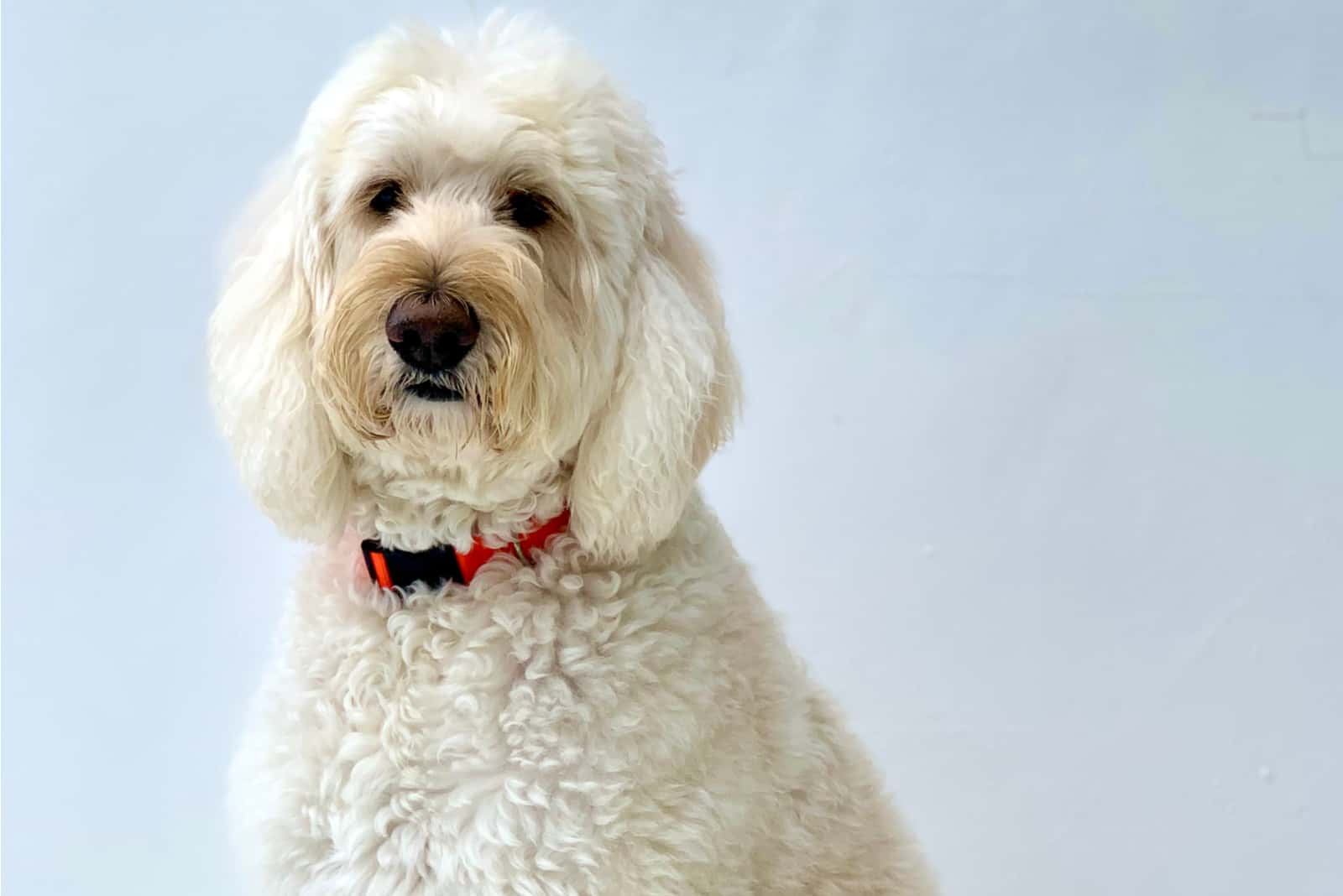
White canines are generally considered a non-standard dog color and are not acknowledged by the AKC. There are claims that white dogs suffer from deafness or other health issues, but that isn’t always the case.
White Doodle inherits its coat shade from its Poodle parent. However, if you look closely at this canine, you’ll notice that white isn’t the only color on its coat.
Some parts of the white Goldendoodle’s coat might have cream markings, especially around the eyes or on the muzzle. These markings might be the heritage of its Golden Retriever parent.
Black and white Goldendoodle
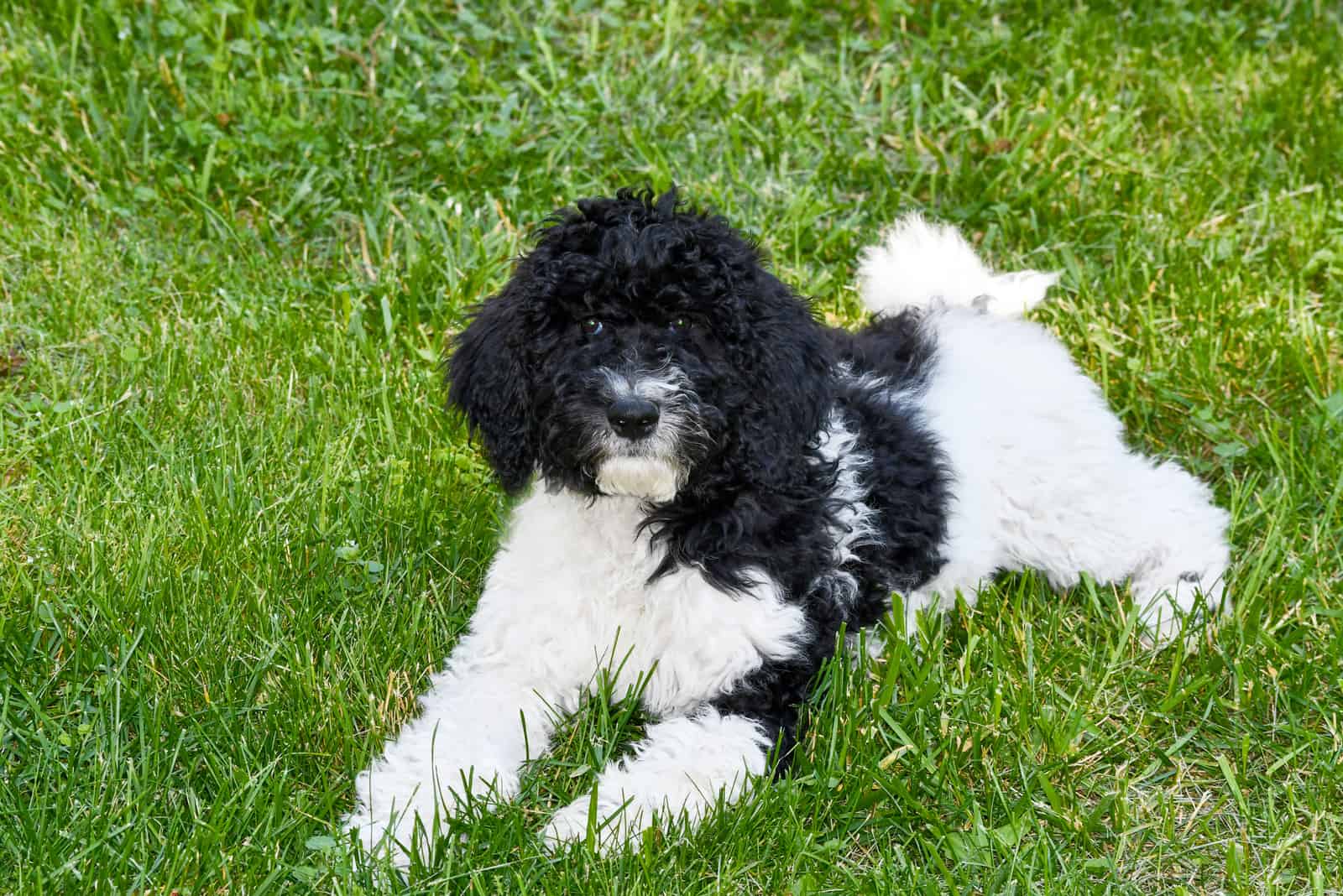
These cuties are a part of the multi-colored Goldendoodle group. This type of Goldendoodle has particular attributes, including a white chest, white and black muzzle, and black markings on the top of the body.
These dogs are generally dominantly white, but in some cases, black can be a dominant color, as well.
Black and white Goldies are often called “Tuxedos” because of the color pattern and markings on their bodies.
However, not all black and white Doodles are meant to be called tuxedos. The Tuxedo Doodle’s coat should have a specific set of markings to be called this way.
Tuxedo Goldendoodles
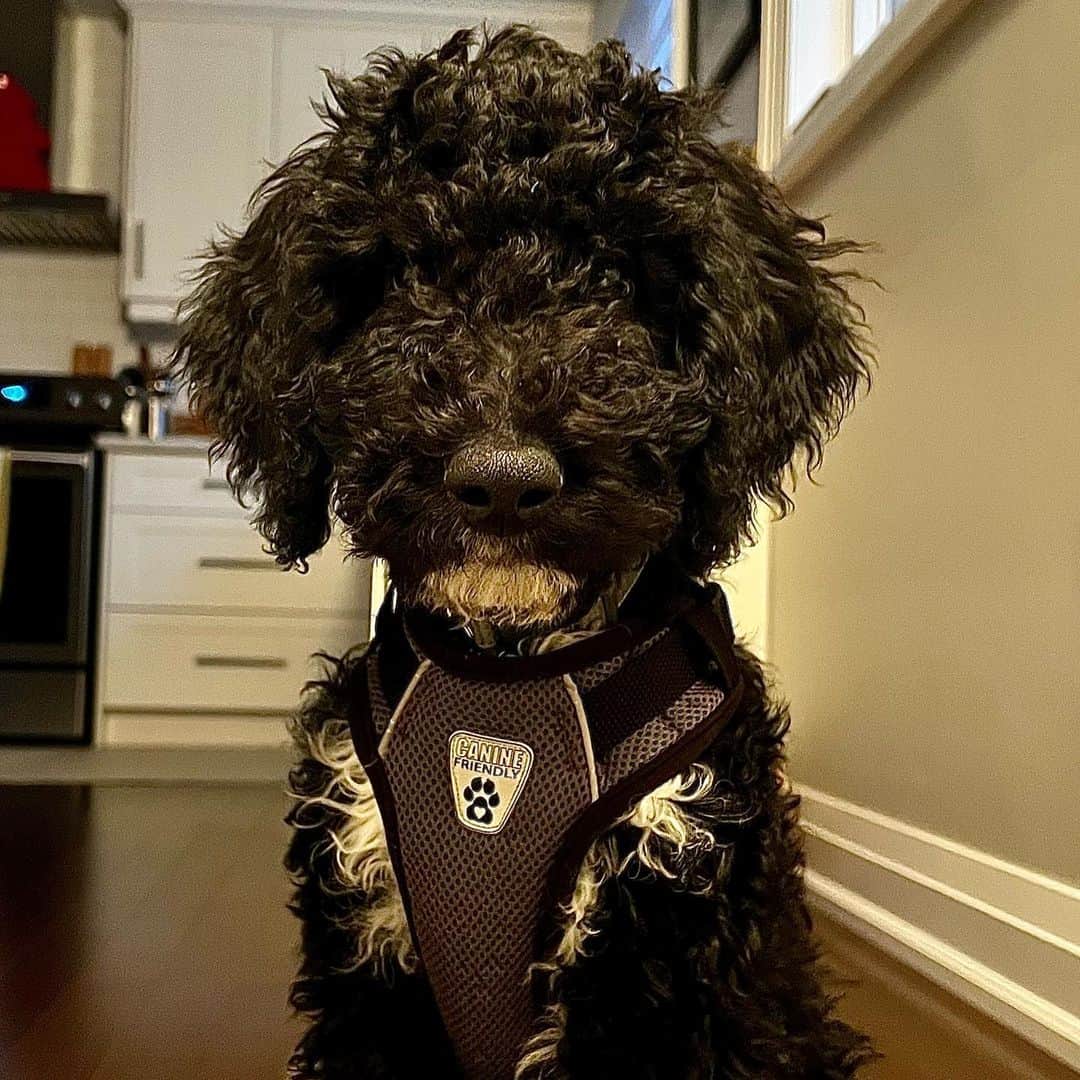
Photo from: @mylointhesix
In order to call a Goldie “Tuxedo Goldendoodle,” the coat hair should be colored in a specific way, so the legs and chests are covered with white color.
This way, these canines look like gentlemen in classy clothes, which is the main reason why they’re called that way.
However, with time, many people started calling all black and white Goldies this way, so the name lost its original meaning in a way.
Parti Goldendoodle
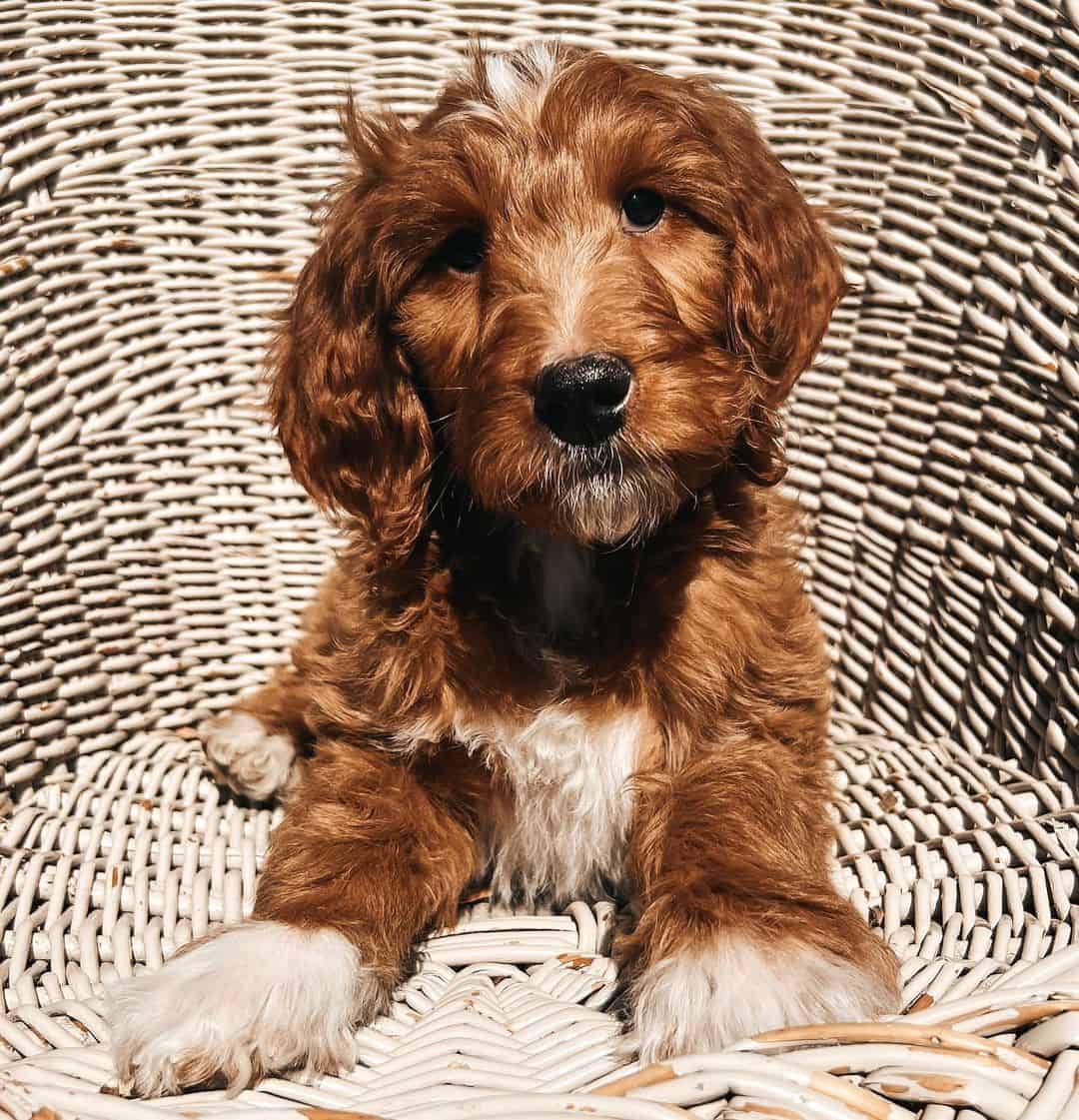
Photo from: @thedotingdoodle
These canines are cuties that are different from other single and multi-color Goldies in a way that their coat colors are equally divided on their body.
Of course, you’re not going to measure whether your pup has precisely a 50-50 ratio of white and any other shade accepted as the breed standard.
However, you can make a rough estimate of the ratio just by looking at your pet’s coat. Since breeders are well-experienced, they can also immediately know whether a dog’s coat is parti or not.
Canines that have fewer white markings on the body are known as abstract, mismarks, and chrome (depending on the percentage of covering).
Getting a parti Goldie isn’t an easy process at all. Since this combination of colors results from the multi-generation breeding of canines with recessive genes, it’s easy to make a mistake if you’re not 100% sure that both dogs carry this type of gene.
If a dominant gene finds its way into the mix, it will be impossible to achieve the same combination of colors.
One way to prevent that is to do a DNA test and ensure that each canine is indeed particolored and possesses a recessive gene.
Sable Goldendoodle
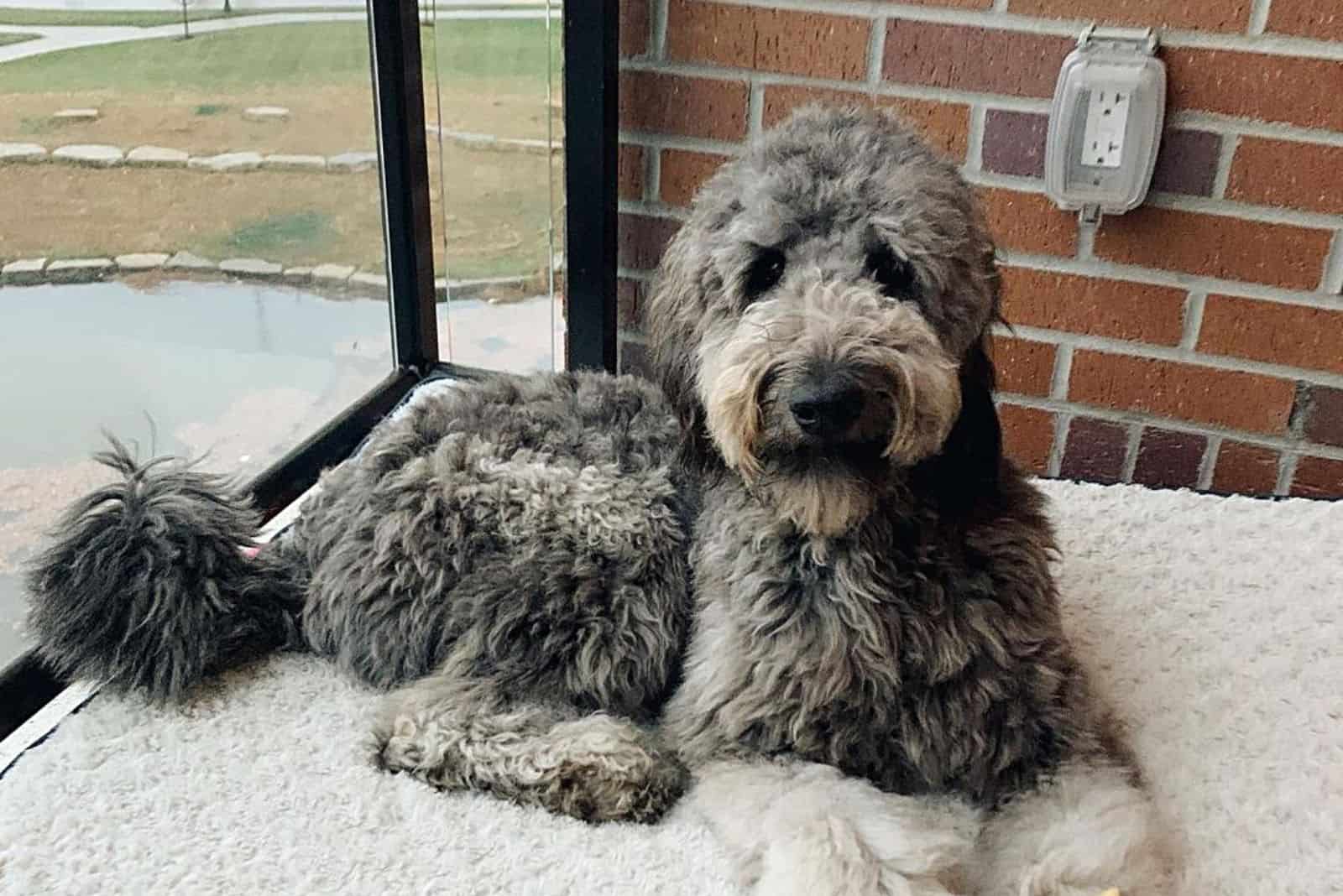
This is one of the rarest Doodle shades that appear later in puppyhood. Almost every sable Goldie is born as a black or dark brown puppy.
However, as the puppies start growing, their dark color turns into a lighter shade that’s interspersed with cream or tan hues.
The most interesting thing about these canines is that their hair remains darker on the tips, but it gets significantly lighter as it becomes closer to the skin.
Some sable Doodles can even have black tips, which means that their original birth color never goes away.
Merle Goldendoodle
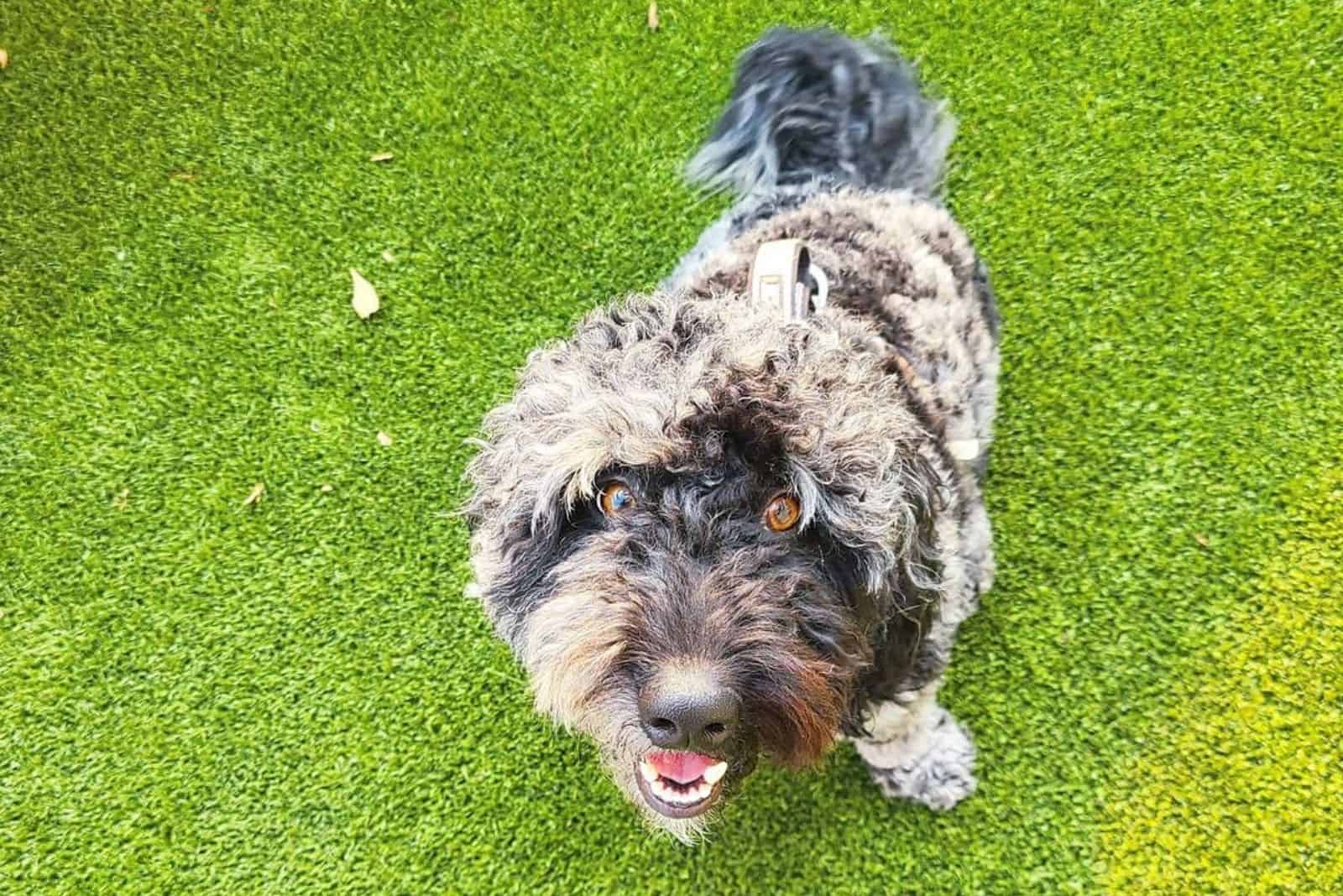
These merle-colored cutie pies are generally considered as one of the sweetest Doodle types because of their fluffy coats covered with beautiful markings.
Merle Doodle pups are generally considered a cross between a Poodle and a Border Collie or an Aussie, but in some cases, they can be the result of breeding Golden Retrievers with Poodles. This is why some people claim there are no “real” merle Goldendoodles, only Aussiedoodles.
Getting a merle-colored Doodle from two Goldendoodles is nearly impossible. It could happen only if the merle gene is dominant enough in the DNA mix of a chocolate or black Doodle.
Essentially, the merle pup gets its color in an opposite way than parti doggies. In order to get the merle pattern, at least one parent of the Goldendoodle should possess dominant genes that will take control of the coloring process and change the solid color of Goldie’s coat.
One merle-colored parent is a must, but two merle Doodle parents are a big no-no. Breeding between two merle Goldies can cause a puppy with numerous health problems, including blindness, hip dysplasia, deafness, etc.
There are two types of merle Doodles: watercolor and classic. The latter ones are generally covered with chocolate or blue markings. They’re more common than the watercolor canines, which also have marks on their coats, but their coats lighten as they grow older, unlike the classic ones.
Brindle Goldendoodle
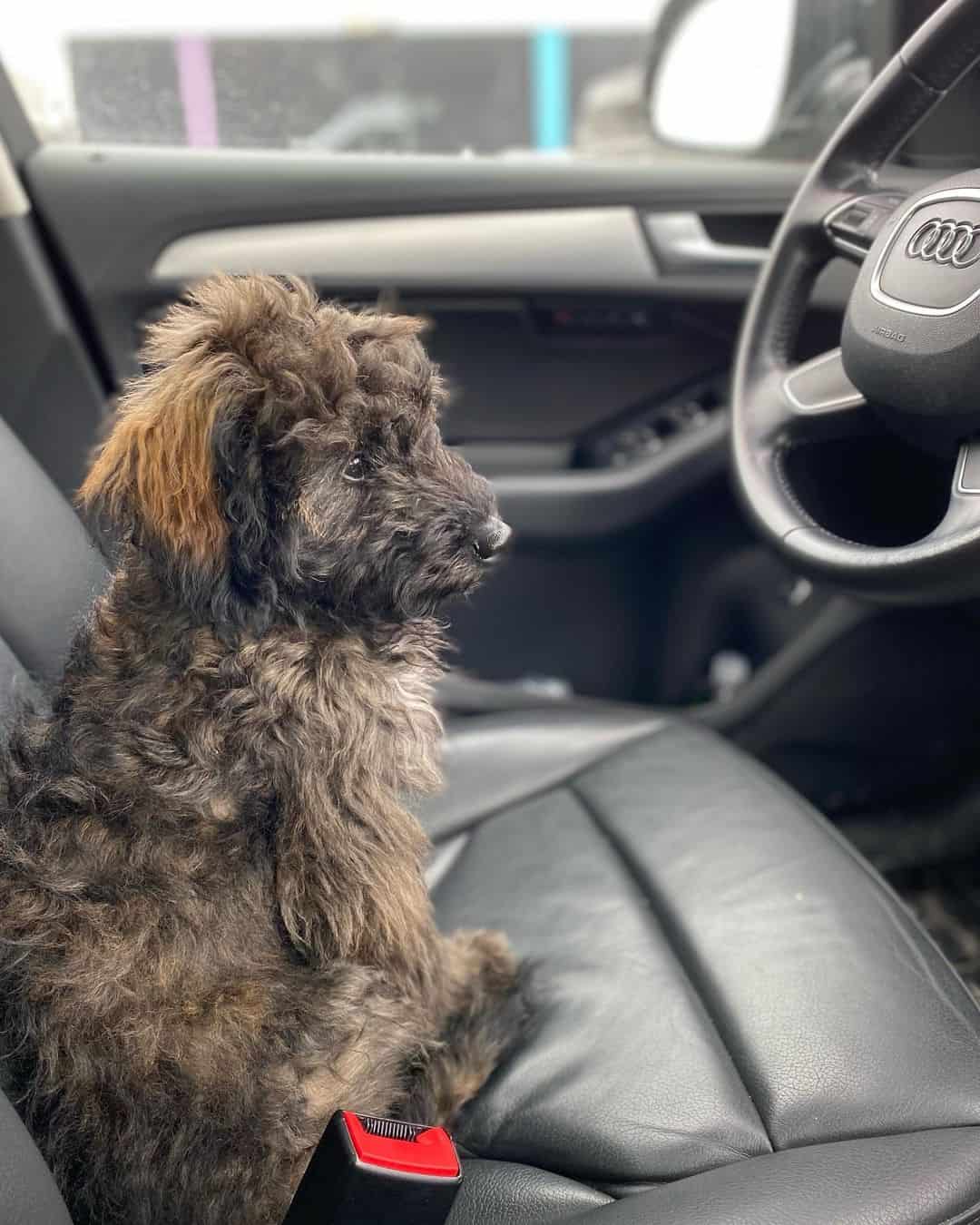
Photo from: @wilson_and_willow_doodlebears
These doggies might look like miniature tigers with their tiger stripes, but they’re just as sweet as all other Goldendoodles.
The color pattern of the Brindle Doodles is very interesting, as it displays black and tanned stripes that appear on the light base of the coat.
You may not display them at dog shows, but these pups will definitely be in the spotlight wherever you go.
Grey Goldendoodle
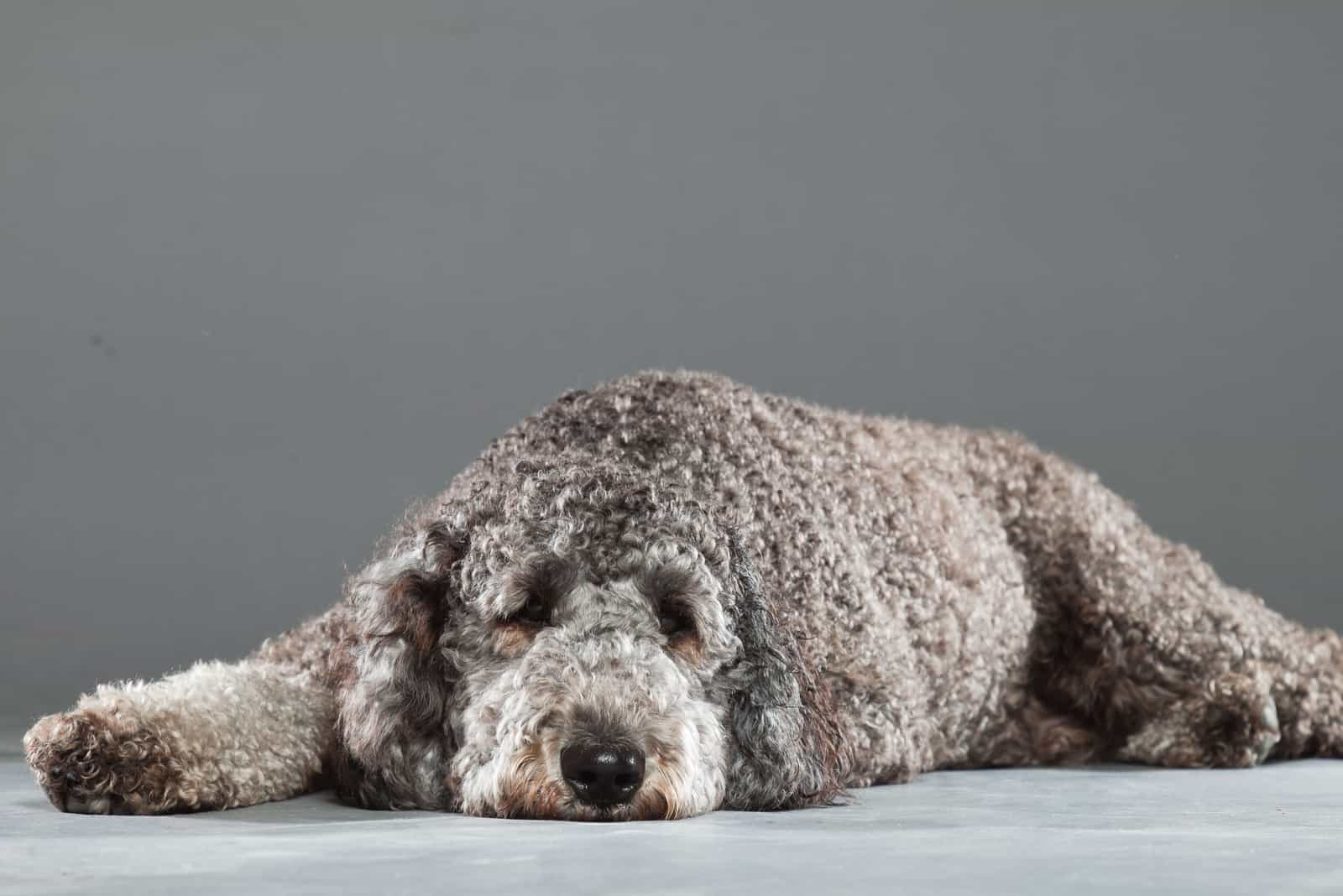
Some people change them for silver Goldendoodles, although they’re essentially not the same color.
Grey Doodles have a lot more in common with silver Poodles than with Golden Retrievers. Doodles usually have a black or dark shade of coat at birth, but it lightens to the grey hue until they’re two years old.
As they grow older, Goldendoodles go through the palette of grey color. Some canines might display a rustic silver color in the end, covering the last trace of the dark shade from early puppyhood.
It usually takes up to six weeks until you finally know whether you got a black or a grey Goldendoodle.
Aussiedoodles might not be Goldendoodles, but they often end up grey. Therefore, if you’re looking for a grey Doodle, you might consider an Aussie one as well.
Phantom Goldendoodle
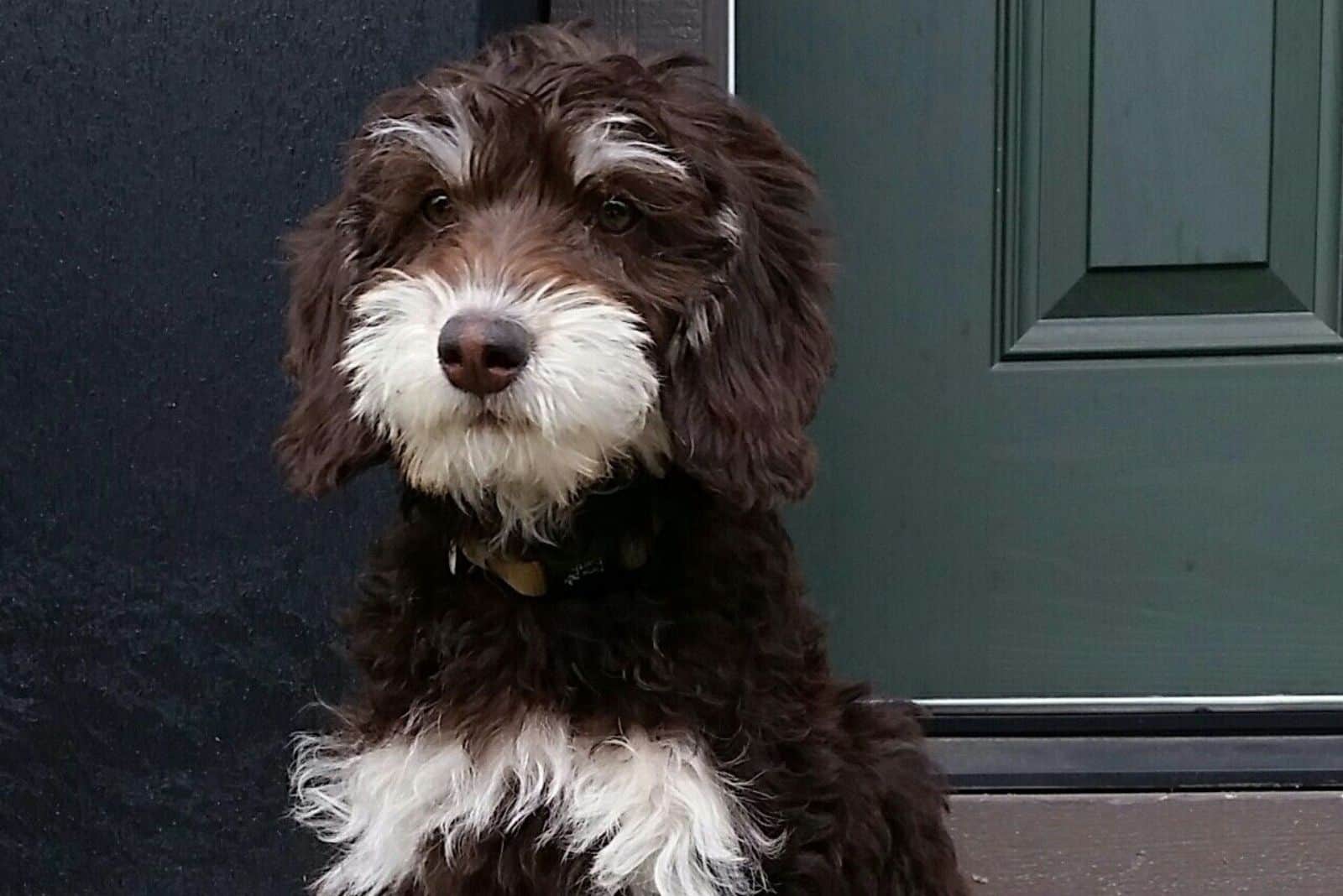
These canines are considered quite unique among Goldendoodles, although they’re often connected to their parti siblings.
This connection isn’t without reason, of course. Phantom Goldies have two dominant colors on their coats, but unlike parti Doodles, these two colors have the exact places on the coat.
The colors are usually placed like the hues of a Yorkie or a Manchester, although they don’t share the same colors.
One of the shades is used as the base hue, the main color of the coat, and the lighter shade, which is usually found around the eyes, nose (on the muzzle), and legs.
The main colors of the Phantom Doodles are usually black as the primary shade and tan as the lighter hue. However, that’s not always the case.
The coat of this Doodle can also be covered with various combinations of black, red, and silver shades, which is why canines of this type of Goldendoodle rarely appear in the same color pattern.
The best way to know whether you got a phantom puppy is to check the coat right after the birth. Unlike other types, phantoms display their color combination right after birth; they don’t show any markings with time as most of the Doodle types.
This type of color is scarce, but it doesn’t have any influence on the Goldendoodle’s behavior, personality traits, or any other characteristics.
Tan Goldendoodle
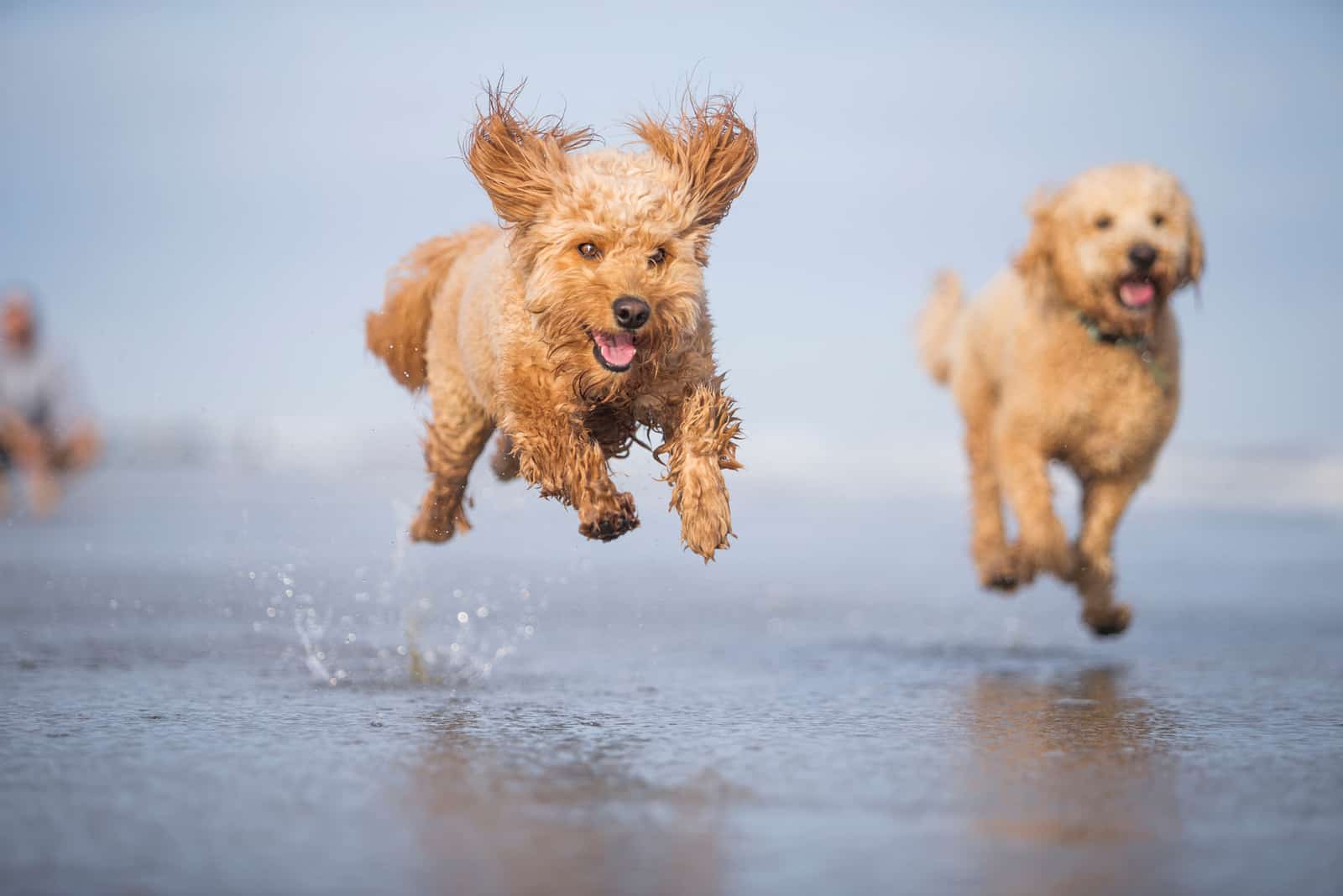
These pups are just adorable, and they’re pretty rare, compared to other colors like apricot or red Doodles.
Plenty of breeders prefer this shade type because it’s lighter than the above colors.
It’s very similar to the apricot shade, so there’s no wonder that people often confuse them. However, a tan Doodle can be a combination of apricot Doodles and the cream Golden Retriever or a diluted red pigment that is also known as pheomelanin.
White might appear in some cases, primarily as markings that remind of the Doodle’s Golden Retriever parent.
Blue Goldendoodle
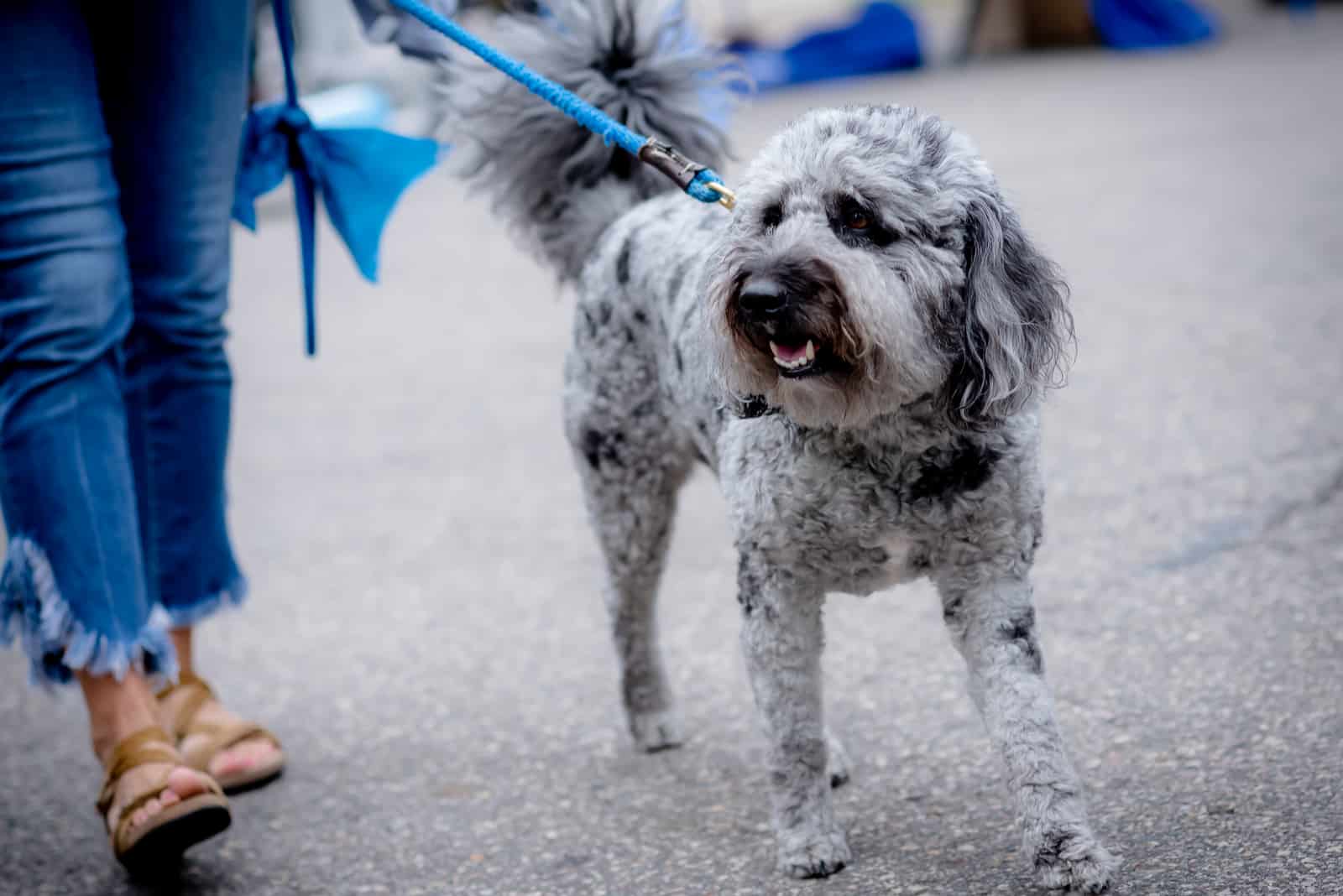
Most people confuse the blue Goldendoodles with their grey relatives. Indeed, they do share a very similar look, but you’ll be able to notice differences between them at a second glance.
Blue Doodles are one of the rarest Goldendoodle types and can appear only due to several generations of breeding Doodles.
The coat is usually covered with a silvery blue color that might lighten as the Goldendoodle ages. However, not all Doodles change color; there are a few exceptions that keep the blue hue even when they become mature.
Silver Goldendoodle
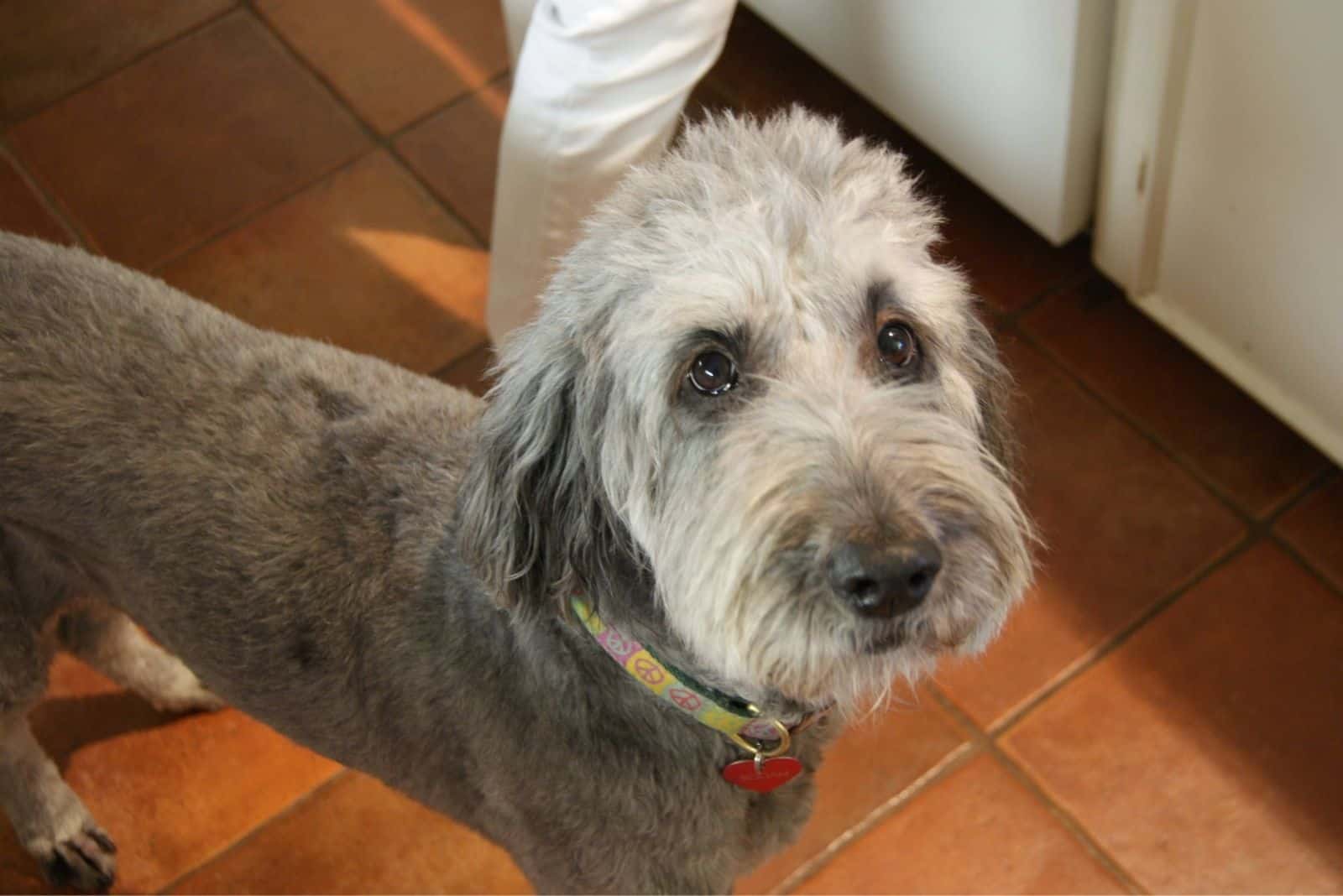
Essentially, the silver color looks just like diluted grey or blue, although it’s considered an individual shade. Just like the majority of Doodles, silver doggies are also born with a dark coat, which lightens over a certain period of time.
Some people describe their coat hair as the hair of an older human, which is why this hue is easily separated from all other colors of Goldendoodles.
Since they’re dark at birth, it might be uneasy about judging which type of Goldendoodle you got immediately. However, after two months of life, you’ll be able to identify your Goldendoodle’s shade which might appear a bit lighter or darker, but you’ll generally know whether it’s a black, grey, or silver Doodle.
This is a solid color that generally doesn’t include any markings on the coat, but the color of the coat might differ in a tone or two, which is why most of the silver Goldendoodles don’t look the same.
Chocolate Goldendoodles
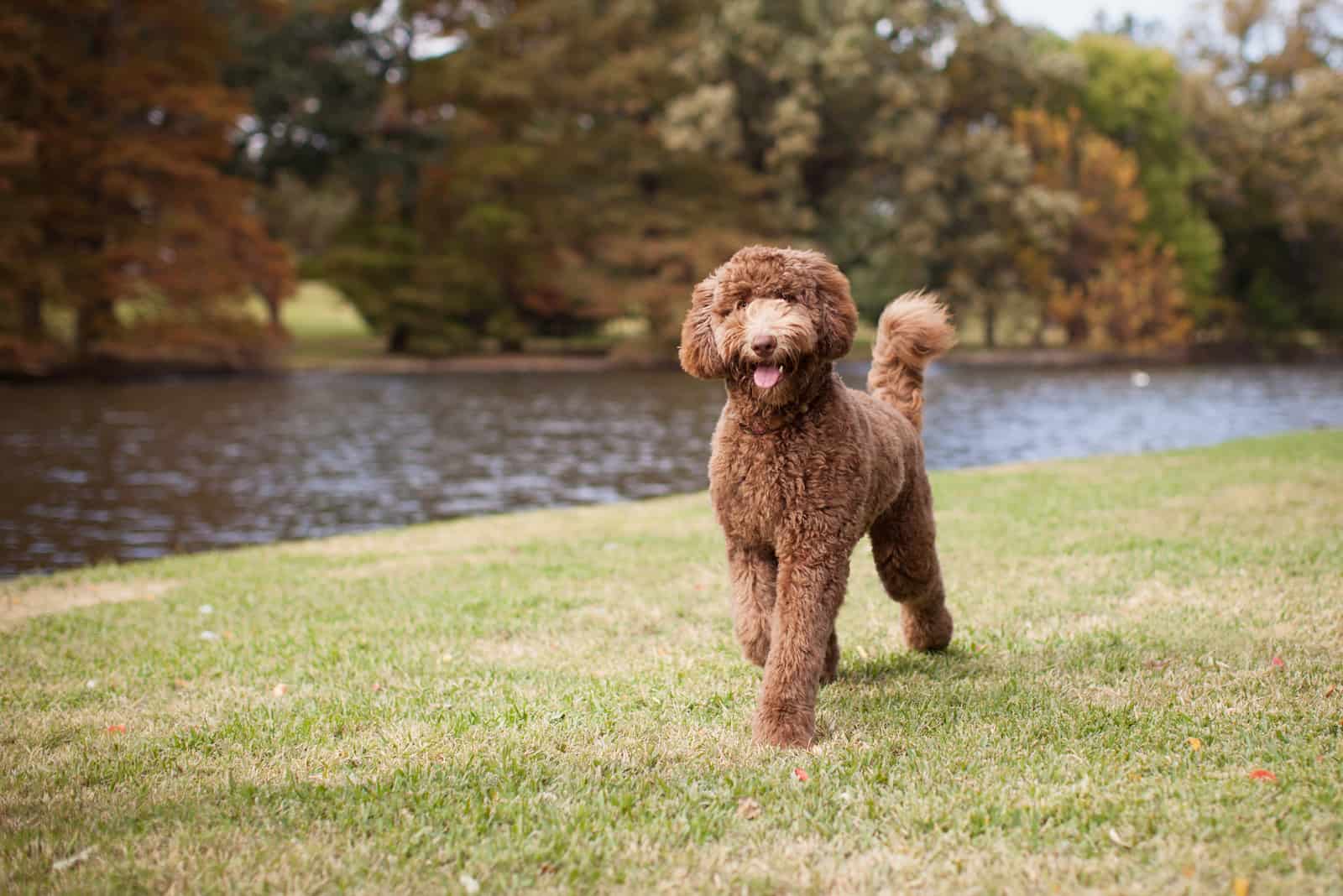
This coat color is so common that it sometimes seems like every other Goldie is covered in chocolate shade.
It’s more than clear that this color comes from the Poodle parent rather than the Golden Retriever.
However, this beautiful coat hair might show the first sign of silvering as Goldendoodles become older.
Silvering
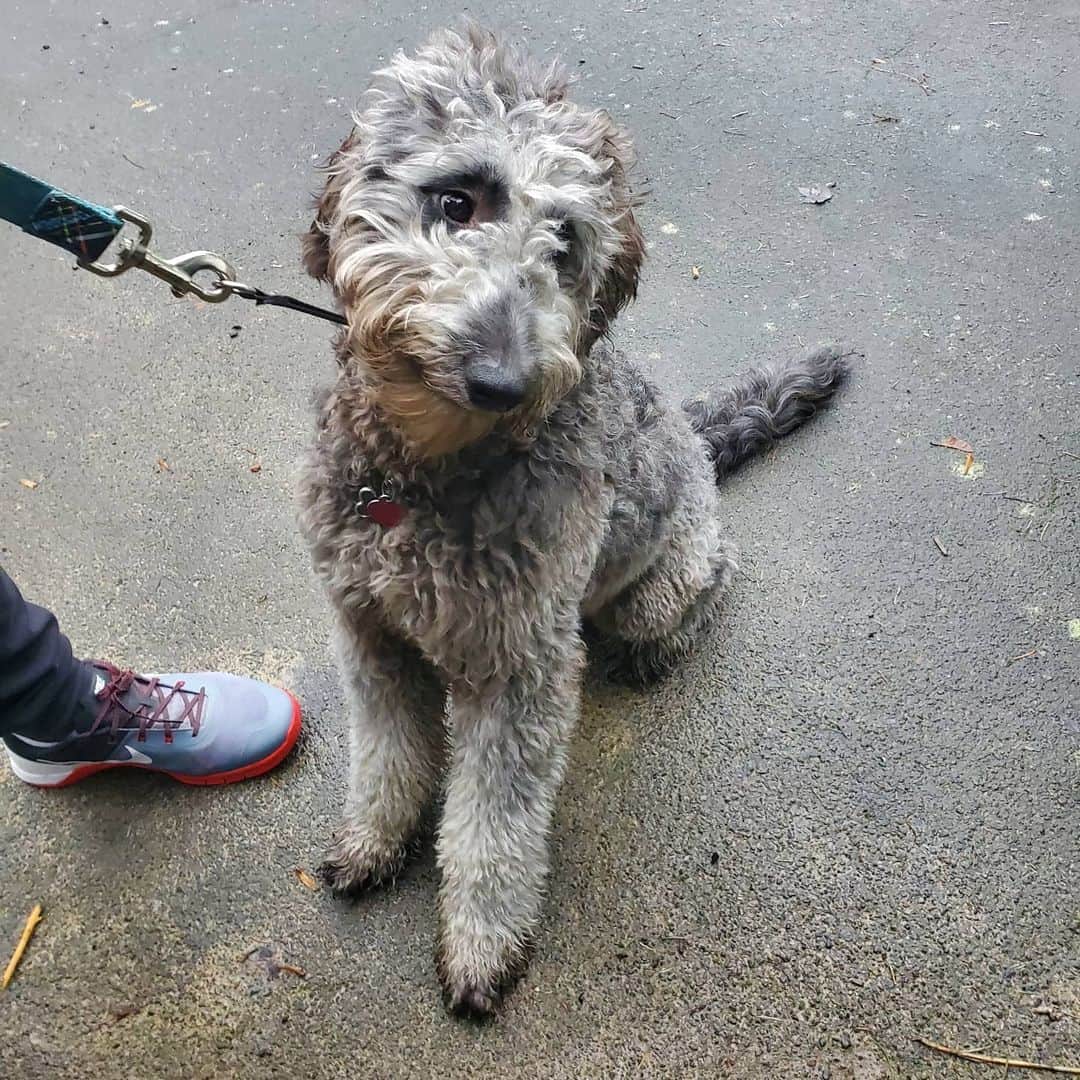
I’m sure that the first thing that came to your mind when you read the expression above was grey hair in your pet’s coat.
But, silvering might not be the same thing as when humans turn grey.
First of all, this occurrence is typical for black and brown canines. Their coat hair loses its pigment as they grow older, but it rarely becomes white.
The coat hair usually ends up in colder sand or silvery cream shades. The color of the silvered hair depends mainly on the dominant gene.
Therefore, if you have a dark chocolate Goldie, it might turn into a canine with rich brown color as it becomes older.
When it comes to the coat color, it’s essential to mention one more thing related to the origin of the chocolate shade.
A puppy of two chocolate Goldendoodles doesn’t necessarily have to be covered in the same shade!
The coat hue depends on the dominance of the gene. The chocolate shade comes from a recessive gene; therefore, the chances of getting a chocolatey puppy are medium to low.
Rarest Colors Of Goldendoodle
Each breed has a unique set of colors that are pretty difficult to find. The rarity of these types of dogs enables breeders to increase their price, especially if they have to be bred under specific circumstances.
The breeding of multiple generations generally produces rare Goldendoodle coat colors, so if you want to own a blue, grey, or silver Goldendoodle, you’ll have to breed the F2 generations and beyond.
These three shades are considered rare colors among the solids. However, most multi-color patterns are quite uncommon as well. Most of these colors are achieved using the same solid shades method.
Goldendoodle Coat Types
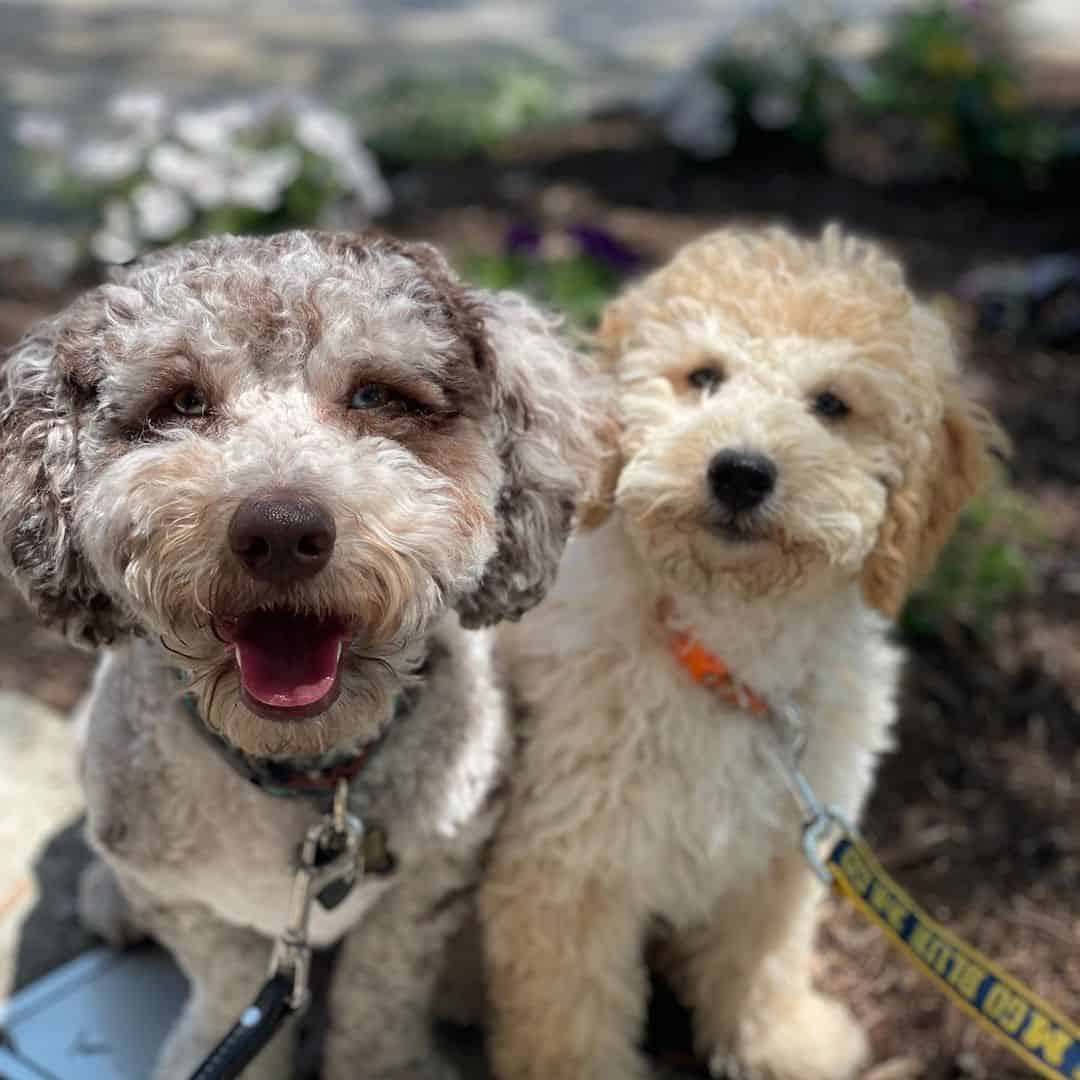
Photo from: @teddy_themerle_dood
The Goldendoodle breed’s coat types can be divided into three groups:
• Curly – This type of coat is inherited from the Poodle ancestors and is typical for F1b or other generations beyond.
• Wavy – This is the most common coat type that appears on the majority of Goldendoodles. There isn’t a generation of Doodles without at least a few pups with wavy coat hair.
• Flat – Goldendoodles with flat coat hair are considered as a serious fault rather than a standard coat type. This is basically a pure aesthetical issue. Flat coat hair resembles Golden Retrievers, and therefore, it’s not up to the cute and fluffy teddy bear standard that most future Goldendoodle owners are looking for.
The type of coat has nothing to do with the canine’s personality and behavior. Therefore, if you’re not that specific about your pup looking like a teddy, you’ll be equally happy with a flat hair Doodle.
Wrapping Up
These hypoallergenic balls of fur and sweetness will surely find a special place in your heart.
However, now that you read everything about the Goldendoodle colors, I hope you’re ready to make the final decision.
It’s not easy to choose between these beautiful shades, but keep in mind that the coat color doesn’t affect a dog’s character or behavior.
I’m sure you’ll be equally satisfied with any color of your choice, but if you’re still indecisive, you can include your family in the final decision!
Read Next: Goldendoodle Puppy Coat Transition And Grooming Guide
